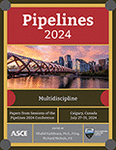Focusing on Accuracy: Directional Drilling along Florida’s Oldest Causeway
Publication: Pipelines 2024
ABSTRACT
The City of Miami Beach, FL, has 28 aerial water/sewer mains located along Florida’s oldest causeway, the Venetian Causeway, which links the City of Miami, FL, to the island City of Miami Beach, FL. The corridor consists of 10 islands connected via 10 bridges in Biscayne Bay, one of Florida’s most protected water bodies. These aerially supported pipelines were determined to be at risk having experienced higher occurrence of failures compared to buried pipelines in the City’s system. This is likely due to their exposure to the corrosive marine environment and from additional stresses from wind loading and wave action from the ever-growing risk of named storm events. In response to pipeline failures and to provide greater long-term reliability, the City of Miami Beach accelerated design and construction of buried replacement pipelines on an emergency basis. Exacerbating the challenge was Miami Dade County’s plan to replace the 1920s era bridges, requiring relocation of the water and sewer mains. The timing of the future bridge construction and the increasing service life risk to the existing pipelines led to the need to find an alternative buried solution. An additional challenge to finding a buried pipeline corridor was Florida’s property laws where private property often extends to underwater lands, thus restricting the available corridor to the existing roadway easement. Environmental restrictions prevented dredged and coffered installations from being viable and ultimately drove alternative evaluation to pursue trenchless options. Alternative analysis evaluated several trenchless installation methods, including microtunneling and deep tunnel alternatives. These options were excluded due to the significant costs and construction time. Ultimately, the study process selected Horizontal Directional Drilling (HDD). The challenge was that, due to the extremely tight and obstructed available corridor, pipeline installation by HDD methods required steering accuracy near the limits of feasibility to meet all project constraints. Therefore, performance specifications for accuracy, both steering, and final as built location were required as part of the design as well as careful coordination the County’s replacement bridge design team to avoid conflicts with future bridge support systems. HDD pipeline design included performance specifications for two primary elements: for acceptance criteria of alignments through the use of specific critical alignment locations indicated in the contract documents at the highest risk locations and for the specific type of as-built survey system with capabilities to survey to an accuracy level high enough to verify that the final pipe locations. Historically, when limit-pushing technologies have been applied under complex conditions, risk sharing techniques have often been included within construction contracts to fairly mitigate and balance risk between the parties best suited to control the risk. With this project pushing the limits of steering guidance and as-built survey technology, risk sharing methods were evaluated and developed to improve the potential for project success.
Get full access to this chapter
View all available purchase options and get full access to this chapter.
REFERENCES
ASCE. (2014). Pipeline Design for Installation by Horizontal Directional Drilling, Manual of Practice 108. Second edition. ASCE.
Swarthout, E. (2023). “Accuracy in HDD: The Importance of Guidance Tools” Presentation, HDD Academy, Scottsdale, AZ.
Information & Authors
Information
Published In
History
Published online: Aug 30, 2024
ASCE Technical Topics:
- Beaches
- Buried pipes
- Coastal engineering
- Coasts, oceans, ports, and waterways engineering
- Construction engineering
- Construction management
- Construction methods
- Continuum mechanics
- Drilling
- Dynamic loads
- Dynamics (solid mechanics)
- Engineering mechanics
- Infrastructure
- Pipeline systems
- Pipelines
- Pipes
- Project management
- Shores
- Solid mechanics
- Structural dynamics
- Structural engineering
- Urban and regional development
- Urban areas
- Wind engineering
- Wind loads
Authors
Metrics & Citations
Metrics
Citations
Download citation
If you have the appropriate software installed, you can download article citation data to the citation manager of your choice. Simply select your manager software from the list below and click Download.
